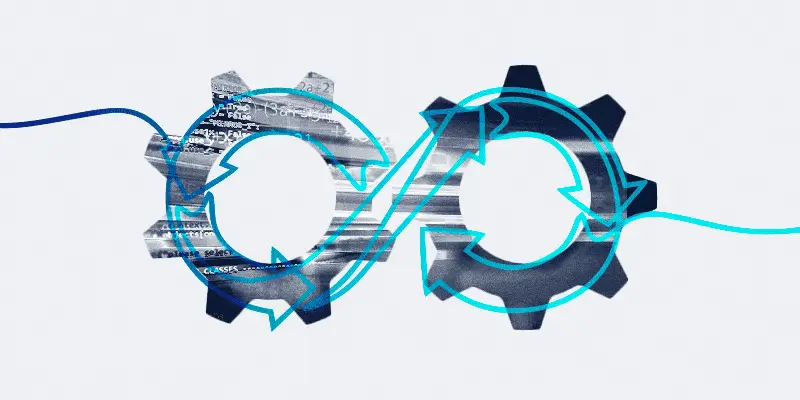How are you going to structure your DevSecOps processes? What tools will be utilized to best achieve your goals? Who will be in charge of specific tasks and who will be responsible for overseeing these initiatives?
Salesforce release management provides the answers to a lot of important questions.
Developing and releasing new applications or updates is a complicated process that involves the efforts of a large team. It is essential to align everybody’s efforts toward a shared goal. And a well thought out release management strategy is the best way to accomplish this.
The DevOps lifecycle consists of six stages:
- Salesforce Release Planning
- Coding
- Building
- Packaging
- Deployment
- Monitoring
These stages feed into the next and have their own dedicated team members. Salesforce release management is the practice of overseeing and managing the various elements of the DevOps lifecycle and offers a series of benefits:
- Improved collaboration
- Streamlined processes
- More successful deployments
- Faster release velocity

So how do you get started with Salesforce release management? What are the first steps and essential considerations?
1. Identify Goals and Analyze Current Processes
Taking the time to honestly assess your DevOps processes and procedures will highlight the areas that most need your attention. The aspects that need the most help will show the fastest improvements if your efforts are properly aligned.
What do you hope to accomplish with Salesforce release management? Which areas have room for improvement?
Answering these questions will help direct your efforts moving forward. Your release management team will take the entire DevOps cycle into consideration, but the areas with the greatest needs can be addressed first. Accomplishing short-term goals contributes to long-term success.
2. Clearly Define Team Member Roles
Now that you have a better understanding of where you current Salesforce DevOps efforts stand, it’s time to put together you team. The first step is to identify the roles that will best accomplish your goals. DevOps includes the efforts of team members from various departments working together, and your Salesforce release management strategy will be the same.
Create and thoroughly define the roles that make up your release management team. Write out the expectations and deliverables for each of these roles.
Failing to properly communicate the expectations of each role leads to confusion and unproductive periods of time.

3. Utilize Automation
Like almost every other aspect of your DevOps pipeline, automation is an essential aspect of streamlining your efforts. There are numerous functions and tasks that are repetitive and time consuming. Utilizing automation frees up your team members while speeding these processes along.
Automated release management performs a series of functions including integrating code changes to the main repository, data loading, metadata management, and more.
Analyzing reports is a great way to assess the success of your Salesforce release management strategy. Automate these reports to access frequent snapshots that can be used to pinpoint successes and opportunities for improvement.
4. Stress the Importance of Testing
A major goal of Salesforce release management is to produce better products as quickly as possible. As we discussed, automation is a large part of accomplishing this. Testing takes that another step further and can even be combined with automation to create the most secure projects possible without sacrificing speed.
Properly testing your updates and applications prior to deployment drastically increases the chances of success.
Static code analysis, CI/CD, and other tools can be implemented to support your testing procedures. Include these in your Salesforce release management strategy to provide the support your team members need to accomplish their goals.
5. Establish a Deployment Schedule
Ideally, your Salesforce release management schedule will be refined over time. Repeated procedures are a major part of reusing a plan and tailoring it to the current project, which we’ll discuss a bit later. Establishing a deployment schedule creates a rubric which can be worked within to accomplish your DevOps goals.
How often would you like to release new updates and applications? Team members and customers alike benefit from knowing what to expect.
Look at your previous deployments and using the timing to put together a basic plan of attack. From there, you can revisit this schedule until you have repeatable processes and a reliable timeline.
6. Repeat Successful Procedures
As we mentioned, the goal is the find a repeatable process to save time on future projects during the Salesforce Release Planning phase. Your Salesforce release management strategy should streamline and optimize your future DevOps projects.

Talk to your team members as you implement new changes in your strategy to find what is working and what needs further improvement.
Use these successes to templatize your DevOps processes. The ability to carry procedures over to the next project makes it more reliable and predictable. Your team will be able to focus on remaining productive when they don’t have to figure out their approach each time.
7. Continually Revisit Your Strategy
Your release management strategy is never perfect. Instead, it should be consistently refined and realigned to better serve your team members and customers. Speaking with your team members, paying attention to deployment success, and analyzing reports will show you what is working and what is not.
What trends have you noticed over the course of the last few DevOps projects? How can this information be used to improve future efforts?
Salesforce release management is a journey and not a destination. Your DevOps needs are constantly changing and so should your approach to your development pipeline.
8. Set Backups on Recurring Schedule
No DevOps strategy is complete without a reliable data backup and recovery plan. Accidents happen. Data loss can occur at any time from a variety of sources. Any loss or corruption to your Salesforce data and metadata will create redundant work, lost productivity, and potentially exposed sensitive information.
Institute a repeated schedule of system backups and have access to a tool that can quickly implement backed up data should a data loss event occur.
Salesforce release management is an ongoing effort to streamline and optimize your DevOps pipeline. Proper care at the outset of the strategy and continually revisiting these procedures will give your team the tools and support they need to accomplish your DevOps goals.
